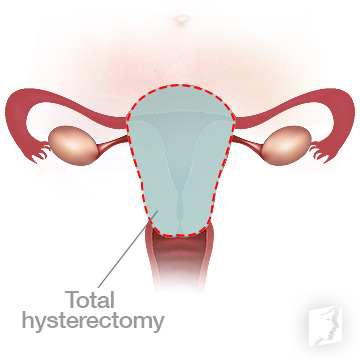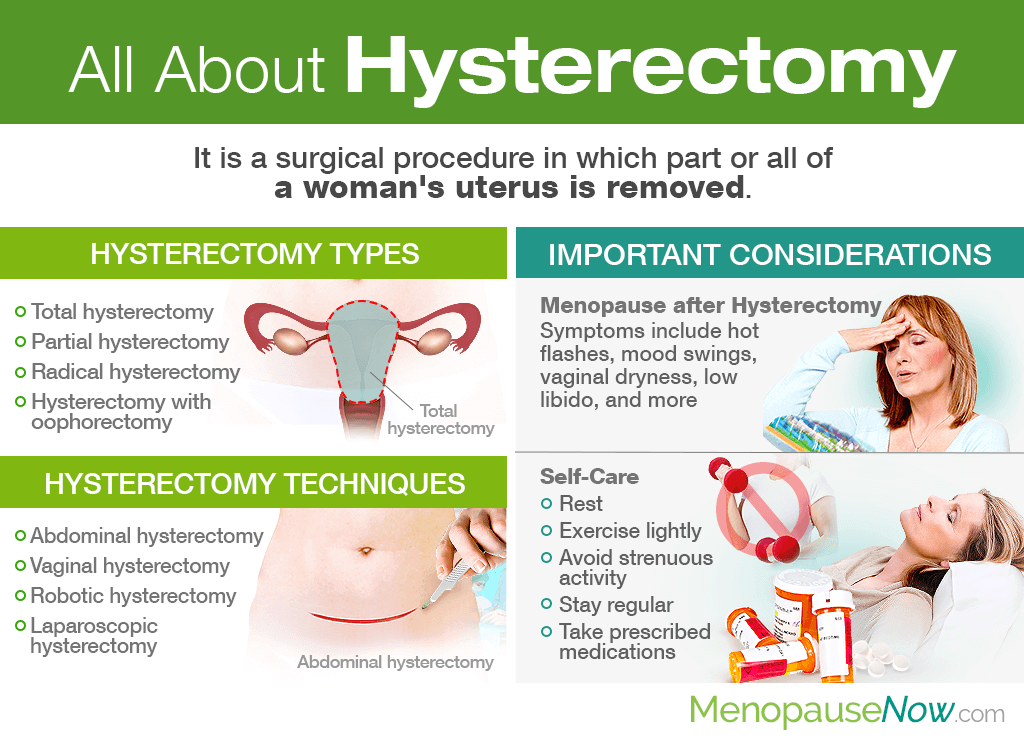Women who are encouraged to pursue a hysterectomy by their doctors are likely to be left with many questions not only about the procedure, but how it will ultimately impact their reproductive health. Continue reading to learn all about hysterectomy, including its types, reasons for hysterectomy, techniques used, hysterectomy cost, important considerations, and much more.
Hysterectomy Types
There are several different types of hysterectomy a woman can undergo, including:
Total hysterectomy. In this procedure, a woman's uterus and cervix are removed. The ovaries are left in place. This is one of the most common types of hysterectomy surgery.
Partial hysterectomy. Also known as a subtotal or supracervical hysterectomy, the uterus is removed, but the cervix is left in place. It is used to treat noncancerous fibroids or endometriosis.
Radical hysterectomy. The ovaries, fallopian tubes, upper part of the vagina, uterus, associated pelvic ligaments, and lymph nodes are removed. This is the most drastic hysterectomy type for women with cancer of the reproductive organs.
Hysterectomy with oophorectomy. This is a hysterectomy surgery during which the uterus and either one or both ovaries are removed.

Reasons for Hysterectomy
Doctors may recommend that women undergo a hysterectomy if they suffer from the following medical conditions:

- Endometriosis, which is when endometrial cells grow outside of the uterus and attach themselves to other organs, causing abnormal bleeding
- Fibroids, which are non-cancerous growths that form within the walls of the uterus, outside of the uterus, or within the uterine cavity
- Adenomyosis happens when endometrial-like cells grow in the muscle of the uterus
- Dysmennorhea, severe menstrual pain due to recurrent endometriosis or adenomyosis
- Prolapse of the uterus falling into the vagina due to damage to the pelvic floor muscles (usually from childbirth) or loose ligaments
- Pelvic inflammatory disease (PID), commonly caused by sexually transmitted infections (STIs)
- Cancer of the fallopian tubes, cervix, uterus, or ovaries
- And more that could be causing reproductive health distress and problems
Hysterectomy Techniques
Hysterectomies can be performed in one of four ways:
Abdominal Hysterectomy

- What is it? A vertical or horizontal incision of six to eight inches long in the abdomen to remove the uterus
- Who is it for? Those with large fibroids, an enlarged uterus, needing removal of ovaries and fallopian tubes, or with diseases of the pelvic cavity, endometriosis, or cancer
- What is the length of recovery? Two to three nights in the hospital and reduced activity for four to six weeks
Vaginal Hysterectomy
- What is it? Removal of the uterus through the vaginal opening
- Who is it for? For those with uterine prolapse
- What is the length of recovery? Zero to one night in the hospital and reduced activity for four to six weeks
Minimally Invasive Laparoscopic Hysterectomy
- What is it? Removal of the uterus through small incisions on the lower abdomen using a laparoscope (thin camera) as a surgical tool
- Who is it for? Those who want less post-procedure pain, but will have small scars
- What is the length of recovery? Zero to one night in the hospital and reduced activity for four to six weeks
Minimally Invasive Robotic Hysterectomy
- What is it? Procedure using high-definition 3D magnification, robotic technology, and miniature instruments to view, manipulate, and remove the uterus and other necessary parts
- Who is it for? Those who want less post-procedure pain, but will have small scars
- What is the length of recovery? Zero to one night in the hospital and reduced activity for four to six weeks
Hysterectomy Cost
In the United States, a hysterectomy is the most common gynecological surgical procedure, accounting for over $5 billion health care dollars each year with 43 percent of women undergoing one by the age of 85.
Without a doubt, the average cost of hysterectomy will depend greatly upon the method of hysterectomy, operative time, and length of stay in the hospital. These average costs are:
- Abdominal: $43,622
- Vaginal: $31,934
- Laparoscopic: $38,312
- Robotic: $49,526
Important Considerations After a Hysterectomy
There are several factors to take into consideration before going through with a hysterectomy procedure, such as:
Risks of Hysterectomy
Short-term risks are generally mild, minimal, and occur within the first month after surgery. They may include:
- Blood clots in the legs or lungs
- Infections
- Anesthesia-related side effects, like nausea and vomiting
- Difficulties with urination
- Damage to surrounding areas, like the bladder, urethra, blood vessels, and nerves
- Blood loss and blood transfusion dangers
- Needing to follow up an abdominal hysterectomy with another technique
A rare, long-term risk of hysterectomy is pelvic prolapse, which is the stretching or dropping of pelvic organs into an abnormal position.
Menopause after Hysterectomy

Women who undergo hysterectomies will no longer have their periods and cannot get pregnant no matter their age.
Also, it is common for women to enter menopause within five years of a hysterectomy surgery due to decreased blood supply to the reproductive organs that are still intact. The menopause symptoms experienced may include hot flashes, mood swings, vaginal dryness, night sweats, low libido, and more.
Self-Care
All hysterectomies include a standardized rest period of four to six weeks during which women are advised to follow firm instructions, such as:

- Rest. Rest lying down as much as possible for at least the first two weeks.
- Exercise lightly. Only participate in doctor-ordered exercises. Try to go for a daily walk unless advised otherwise.
- Avoid strenuous activity. This includes heavy lifting, stretching, and standing for more than a few minutes at a time.
- Stay regular. Avoid constipation by drinking plenty of fluids and consuming an abundance of fresh fruits and vegetables. Take stool softeners if instructed.
- Take prescribed medications. Even if feeling better within the first couple days, it is important to take the full course of prescribed antibiotics.
- Avoid sex. Until your first post-operative check-up, avoid vaginal sex so as not to compromise the healing process.
Alternatives to Hysterectomy
Sometimes a hysterectomy is deemed necessary, as is the case with women with certain types of cancer, but there are other treatments available. Speak with your doctor about the best option for your personal health status.
Because endometriosis or fibroids are hormone-depending conditions, some of the best alternatives to hysterectomy deal with the root cause, hormonal imbalance.
Women seeking relief, especially those in search of menopause symptoms treatments, can implement various lifestyle changes of an improved diet, regular exercise, and healthy habits paired with alternative medicine proven to encourage the health of the endocrine system during these transformative years.
Sources
- NHS. (2019). Considerations: Hysterectomy. Retrieved April 9, 2019, from https://www.nhs.uk/conditions/hysterectomy/considerations/
- Office on Women's Health. (2014). Hysterectomy. Retrieved April 9, 2019, from https://www.womenshealth.gov/a-z-topics/hysterectomy
- Stanford Health Care. (n.d.). Hysterectomy. Retrieved April 9, 2019, from https://stanfordhealthcare.org/medical-treatments/h/hysterectomy.html
- Victoria State Government. (2018). Hysterectomy. Retrieved April 9, 2019, from https://www.betterhealth.vic.gov.au/health/conditionsandtreatments/hysterectomy
- Wright, K.N. et al. (2012). Costs and Outcomes of Abdominal, Vaginal, Laparoscopic and Robotic Hysterectomies. Journal of the Society of Laparoendoscopic Surgeons, 16(4), 519-524. doi: 10.4293/108680812X13462882736736

